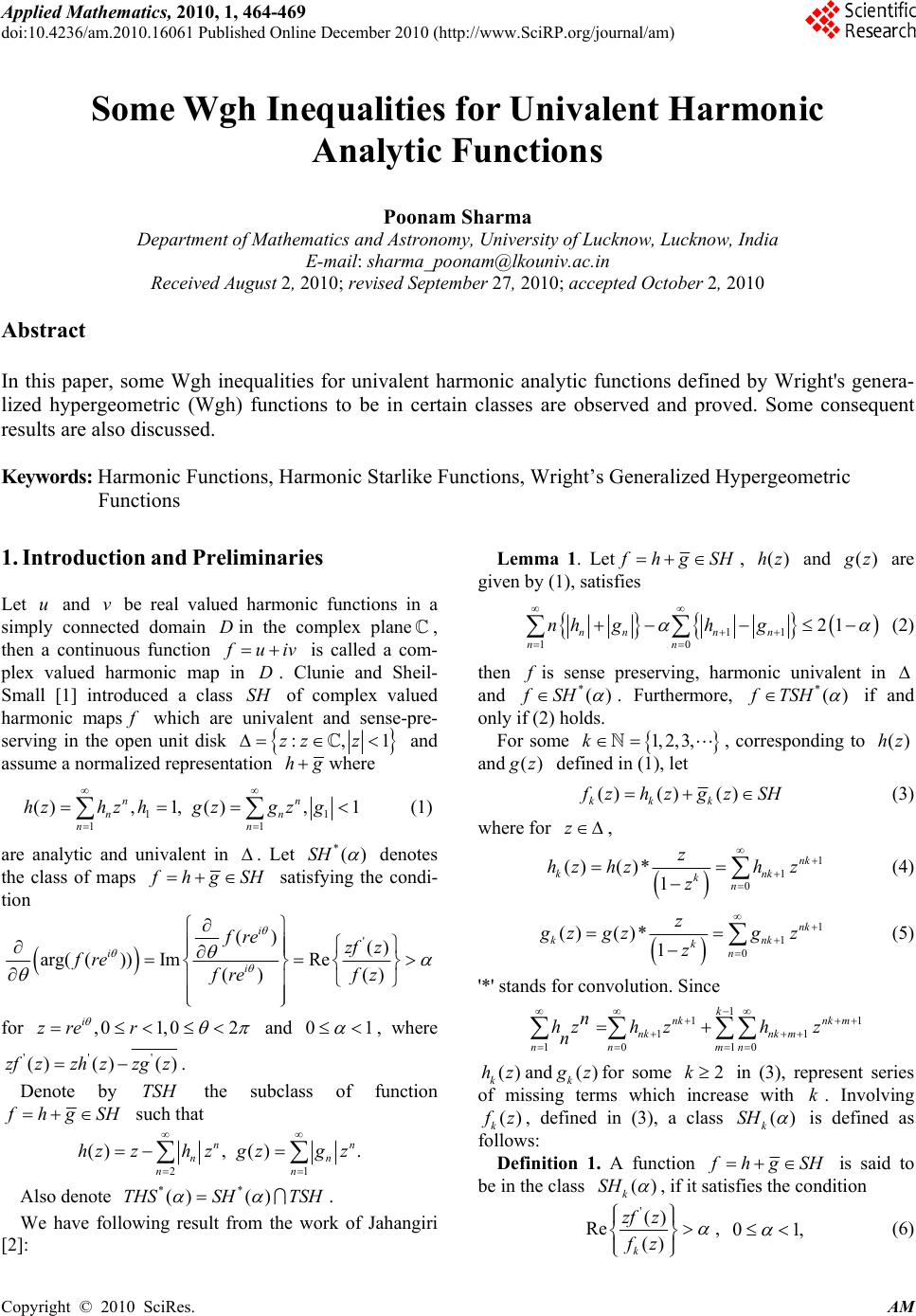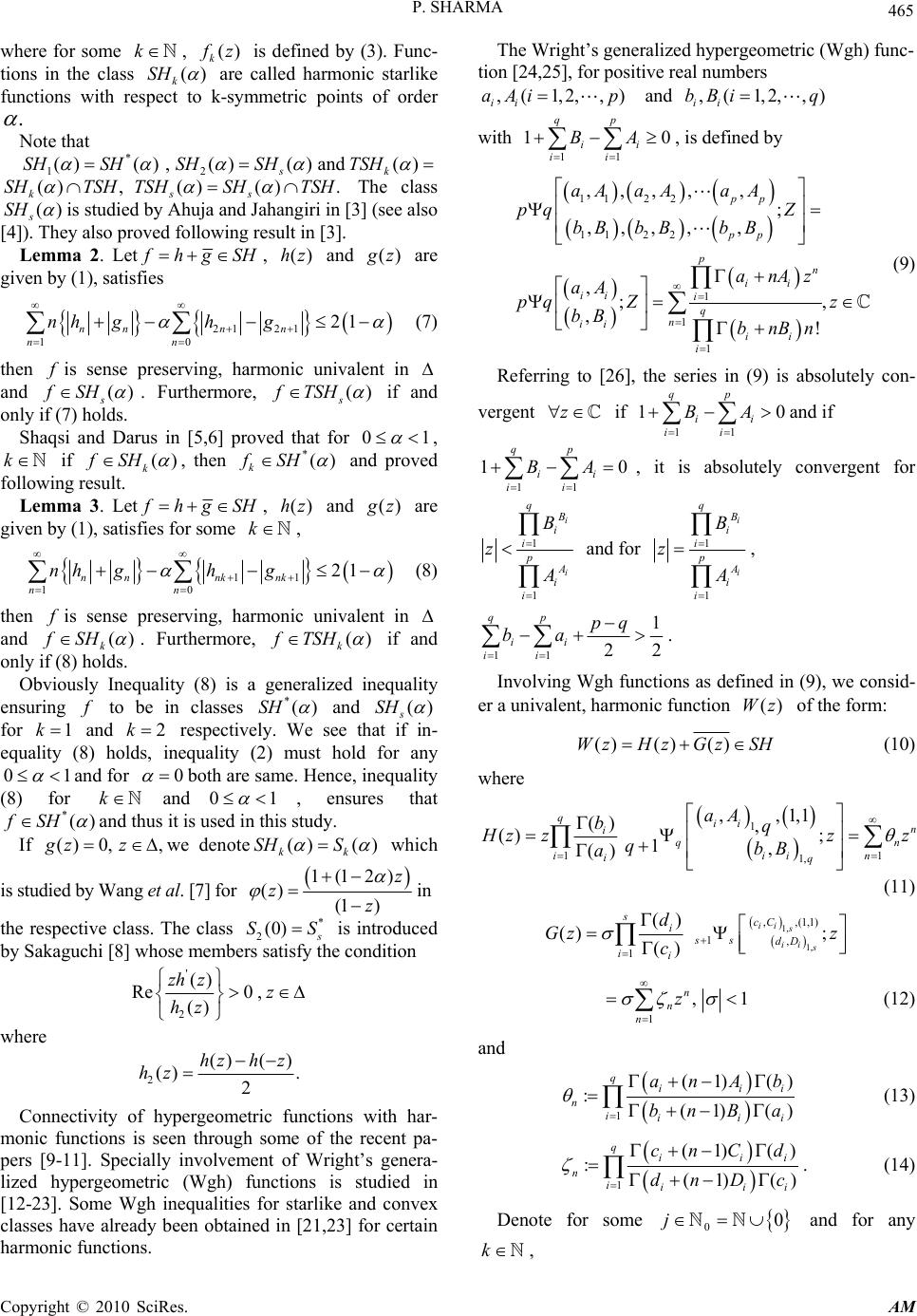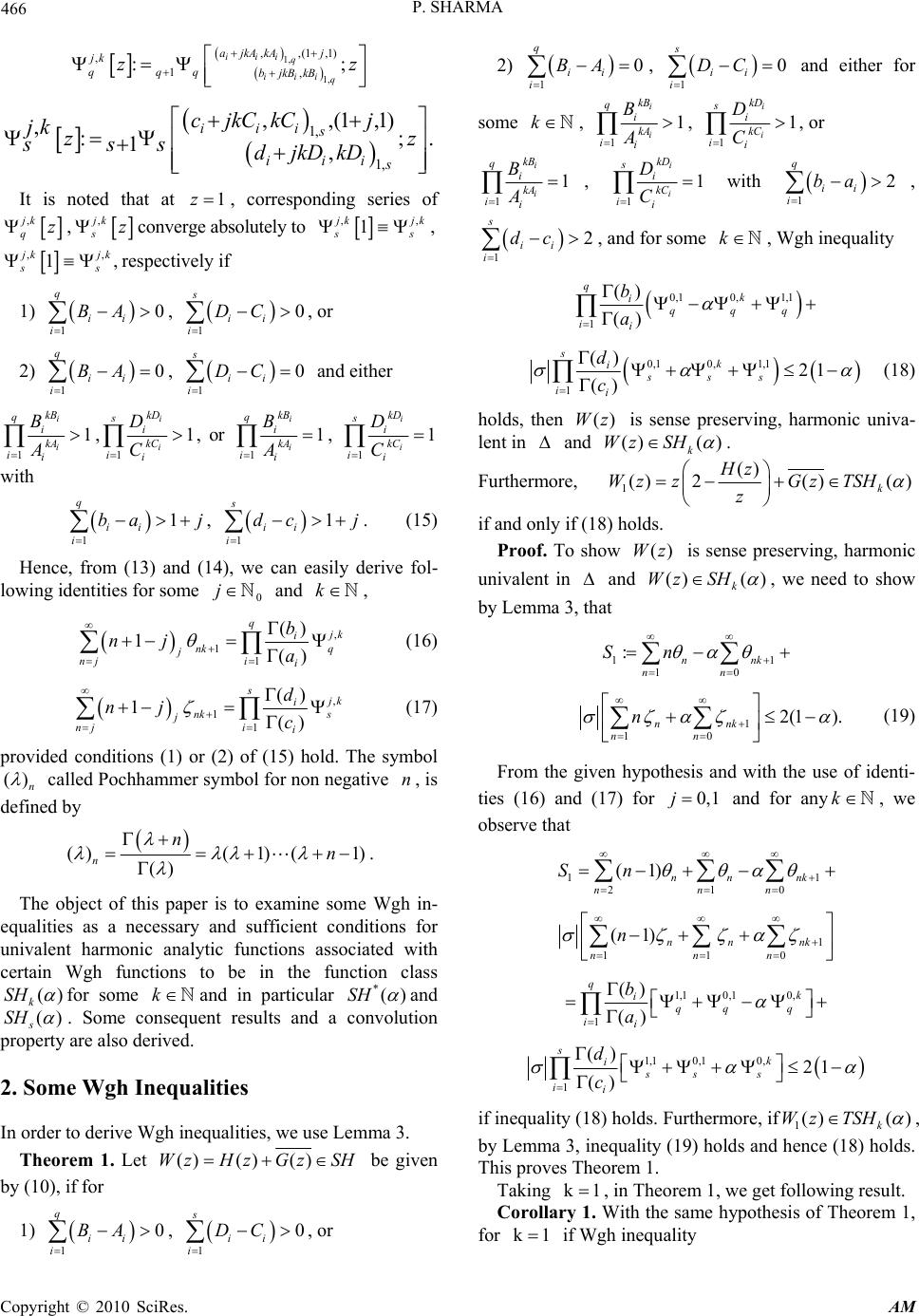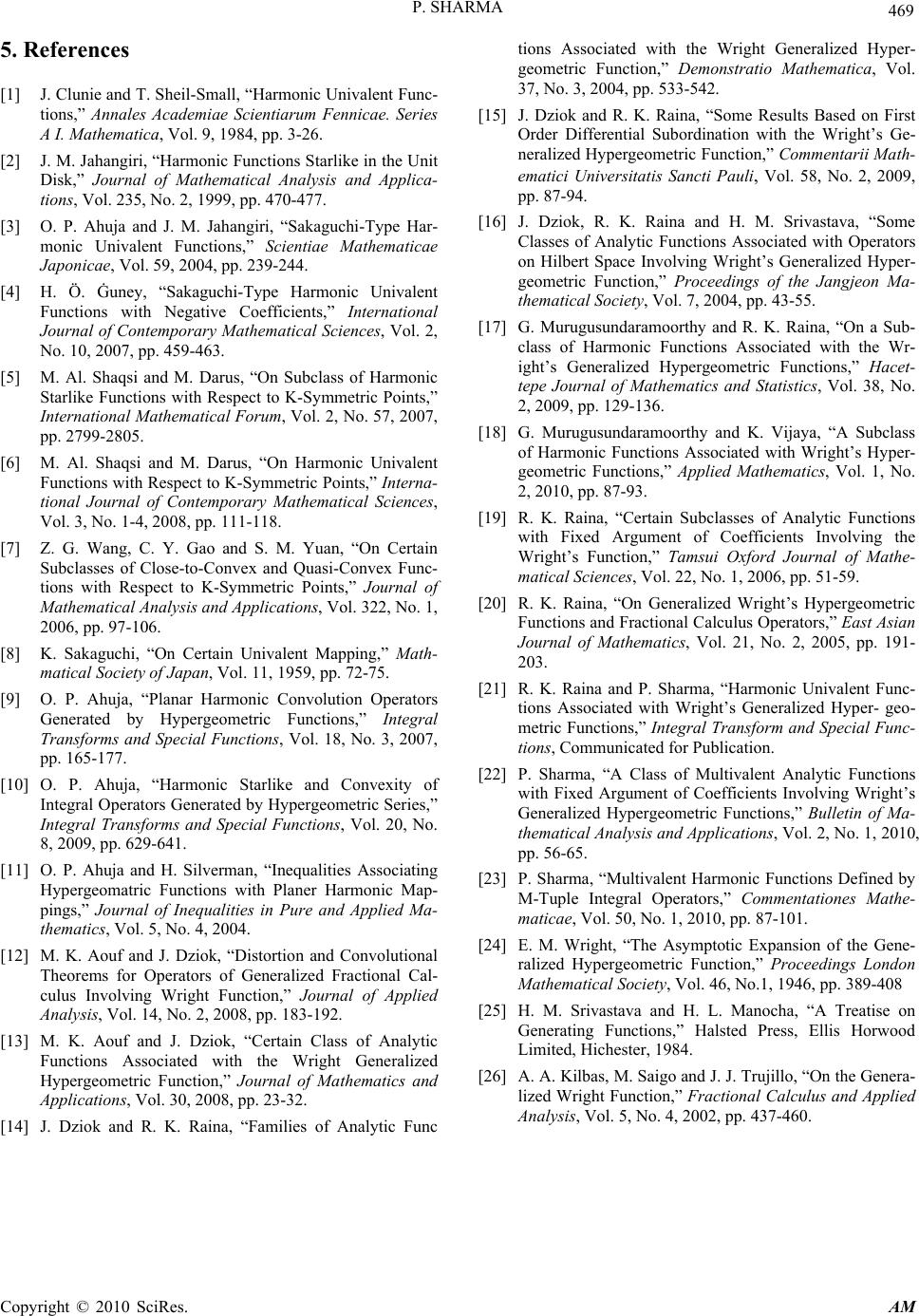Paper Menu >>
Journal Menu >>
 Applied Mathematics, 2010, 1, 464-469 doi:10.4236/am.2010.16061 Published Online December 2010 (http://www.SciRP.org/journal/am) Copyright © 2010 SciRes. AM Some Wgh Inequalities for Univalent Harmonic Analytic Functions Poonam Sharma Department of Mathematics and Astron o my, Uni versi ty of Lucknow , L ucknow , In di a E-mail: sharma_poonam@lkouniv.ac.in Received August 2, 2010; revised September 27, 2010; accepted October 2, 2010 Abstract In this paper, some Wgh inequalities for univalent harmonic analytic functions defined by Wright's genera- lized hypergeometric (Wgh) functions to be in certain classes are observed and proved. Some consequent results are also discussed. Keywords: Harmonic Functions, Harmonic Starlike Functions, Wright’s Generalized Hypergeometric Functions 1. Introduction and Preliminaries Let u and v be real valued harmonic functions in a simply connected domain Din the complex plane, then a continuous function f uiv is called a com- plex valued harmonic map in D. Clunie and Sheil- Small [1] introduced a class SH of complex valued harmonic maps f which are univalent and sense-pre- serving in the open unit disk :,1zz z and assume a normalized representation hgwhere 11 11 (),1, (),1 nn nn nn hzhz hgzgzg (1) are analytic and univalent in . Let *()SH denotes the class of maps f hgSH satisfying the condi- tion ' () () arg( ())ImRe() () i i i fre zf z fre fz fre for ,0 1,02 i zre r and 01 , where ''' ()() ()zfzzh zzgz. Denote by TSH the subclass of function f hgSH such that 21 (), (). nn nn nn hzzh zgzgz Also denote ** () ()THSSH TSH . We have following result from the work of Jahangiri [2]: Lemma 1. Let f hgSH , ()hz and () g z are given by (1), satisfies 11 10 21 nnn n nn nh ghg (2) then f is sense preserving, harmonic univalent in and *()fSH . Furthermore, *()fTSH if and only if (2) holds. For some 1,2, 3,k , corresponding to ()hz and () g z defined in (1), let () () () kkk f zhzgzSH (3) where for z , 1 1 0 () ()*1 nk knk kn z hz hzhz z (4) 1 1 0 () ()*1 nk knk kn z g zgz gz z (5) '*' stands for convolution. Since 1 11 11 10 10 k nknk m nknk m nn mn n hzhzhz n () k hzand() k g zfor some 2k in (3), represent series of missing terms which increase with k. Involving () k f z, defined in (3), a class () k SH is defined as follows: Definition 1. A function f hgSH is said to be in the class () k SH , if it satisfies the condition '() Re () k zf z fz , 01, (6)  P. SHARMA Copyright © 2010 SciRes. AM 465 where for some k, () k f z is defined by (3). Func- tions in the class () k SH are called harmonic starlike functions with respect to k-symmetric points of order . Note that * 1() ()SH SH ,2() () s SH SH and () k TSH () , k SH TSH () (). ss TSHSH TSH The class () s SH is studied by Ahuja and Jahangiri in [3] (see also [4]). They also proved following result in [3]. Lemma 2. Let f hgSH , ()hz and () g z are given by (1), satisfies 21 21 10 21 nnn n nn nh ghg (7) then f is sense preserving, harmonic univalent in and () s fSH . Furthermore, () s fTSH if and only if (7) holds. Shaqsi and Darus in [5,6] proved that for 01 , k if () k fSH , then *() k fSH and proved following result. Lemma 3. Let f hgSH , ()hz and () g z are given by (1), satisfies for some k, 11 10 21 n nnknk nn nh ghg (8) then f is sense preserving, harmonic univalent in and () k fSH . Furthermore, () k fTSH if and only if (8) holds. Obviously Inequality (8) is a generalized inequality ensuring f to be in classes *()SH and () s SH for 1k and 2k respectively. We see that if in- equality (8) holds, inequality (2) must hold for any 01 and for 0 both are same. Hence, inequality (8) for kand 01 , ensures that *()fSH and thus it is used in this study. If ()0,,gz zwe denote()() kk SH S which is studied by Wang et al. [7] for 1(12) () (1 ) z zz in the respective class. The class * 2(0) s SS is introduced by Sakaguchi [8] whose members satisfy the condition ' 2 () Re 0 () zh z hz ,z where 2 ()() () . 2 hzh z hz Connectivity of hypergeometric functions with har- monic functions is seen through some of the recent pa- pers [9-11]. Specially involvement of Wright’s genera- lized hypergeometric (Wgh) functions is studied in [12-23]. Some Wgh inequalities for starlike and convex classes have already been obtained in [21,23] for certain harmonic functions. The Wright’s generalized hypergeometric (Wgh) func- tion [24,25], for positive real numbers ,( 1,2,,) ii aAi p and ,( 1,2,,) ii bBi q with 11 10 qp ii ii BA , is defined by 112 2 112 2 1 1 1 ,,,,, ; ,,,, , ,;, ,! pp pp pn ii ii iq n ii ii i aAaAa A pq Z bBbBb B anAz aA pq Zz bB bnBn (9) Referring to [26], the series in (9) is absolutely con- vergent z if 11 10 qp ii ii BA and if 11 10 qp ii ii BA , it is absolutely convergent for 1 1 i i q B i ipA i i B z A and for 1 1 i i q B i ipA i i B z A , 11 1 22 qp ii ii pq ba . Involving Wgh functions as defined in (9), we consid- er a univalent, harmonic function ()Wz of the form: ()()()WzHz GzSH (10) where 1 1 11, ,,1,1 () , () ; 1, () qii n iqn n ii iiq aA bq H zzz z qbB a (11) 1, 1, ,,(1,1) 1, 1 () () ; () iis iis scC iss dD ii d Gz z c 1 ,1 n n n z (12) and 1 (1) () :(1) () qiii niiii anAb bnB a (13) 1 (1) () :(1) () qiii niiii cnC d dnDc . (14) Denote for some 00j and for any k ,  P. SHARMA Copyright © 2010 SciRes. AM 466 1, 1, ,,(1,1) , 1, :; iii q iii q ajkAkA j jk qqqbjkBkB z z 1, 1, ,,(1,1) ,:;. 1, iii s iii s cjkC kCj jk zz sss djkD kD It is noted that at 1z, corresponding series of ,jk qz, ,jk szconverge absolutely to ,, 1 j kjk s s , ,, 1, j kjk ss respectively if 1) 1 0 q ii i BA , 1 0 s ii i DC , or 2) 1 0 q ii i BA , 1 0 s ii i DC and either 1 1 i i kB qikA ii B A , 1 1 i i kD sikC ii D C , or 1 1 i i kB qikA ii B A , 1 1 i i kD sikC ii D C with 1 1 q ii i ba j , 1 1 s ii i dc j . (15) Hence, from (13) and (14), we can easily derive fol- lowing identities for some 0 j and k, , 1 1 () 1() q j k i nk q j nj ii b nj a (16) , 1 1 () 1() s j k i nk s j nj ii d nj c (17) provided conditions (1) or (2) of (15) hold. The symbol () n called Pochhammer symbol for non negative n, is defined by ()(1) (1) () n nn . The object of this paper is to examine some Wgh in- equalities as a necessary and sufficient conditions for univalent harmonic analytic functions associated with certain Wgh functions to be in the function class () k SH for some kand in particular *()SH and () s SH . Some consequent results and a convolution property are also derived. 2. Some Wgh Inequalities In order to derive Wgh inequalities, we use Lemma 3. Theorem 1. Let ()()()WzHz GzSH be given by (10), if for 1) 1 0 q ii i BA , 1 0 s ii i DC , or 2) 1 0 q ii i BA , 1 0 s ii i DC and either for some k , 1 1 i i kB qikA ii B A , 1 1 i i kD sikC ii D C , or 1 1 i i kB qikA ii B A , 1 1 i i kD sikC ii D C with 1 2 q ii i ba , 1 2 s ii i dc , and for some k, Wgh inequality 0,10, 1,1 1 () () qk iqqq ii b a 0,10, 1,1 1 () 21 () sk isss ii d c (18) holds, then ()Wz is sense preserving, harmonic univa- lent in and ()( ) k Wz SH . Furthermore, 1 () ()2()( ) k Hz WzzGz TSH z if and only if (18) holds. Proof. To show ()Wz is sense preserving, harmonic univalent in and ()( ) k Wz SH , we need to show by Lemma 3, that 11 10 :nnk nn Sn 1 10 2(1 ). nnk nn n (19) From the given hypothesis and with the use of identi- ties (16) and (17) for 0,1j and for anyk , we observe that 11 210 (1) nn nk nnn Sn 1 110 (1) nn nk nnn n 1,1 0,10, 1 () () qk iqq q ii b a 1,1 0,10, 1 () 21 () sk iss s ii d c if inequality (18) holds. Furthermore, if1()( ) k Wz TSH , by Lemma 3, inequality (19) holds and hence (18) holds. This proves Theorem 1. Taking k1 , in Theorem 1, we get following result. Corolla ry 1. With the same hypothesis of Theorem 1, for k1 if Wgh inequality  P. SHARMA Copyright © 2010 SciRes. AM 467 0,11,1 1 0,1 1,1 1 () 1 () () (1)2 1, () qiqq ii siss ii b a d c (20) holds, then ()Wz is sense preserving, harmonic univa- lent in and * ()( )Wz SH . Furthermore, * 1 () ()2()( ) Hz WzzGz TSH z if and only if (20) holds. Remark 1. Taking (1,2,,) ii A Bi q and (1,2,,) ii CDi s, the inequality of Corollary 1 coincides with Theorem 3.1 in [23] for p 1. Taking k2 in Theorem 1, we get following result. Corolla ry 2. With the same hypothesis of Theorem 1, for k2 if Wgh inequality 0,10,2 1,1 1 () () qiqqq ii b a 0,10,2 1,1 1 () 21 () sisss ii d c (21) holds, then ()Wz is sense preserving, harmonic univa- lent in and ()( ) s Wz SH . Furthermore, 1 () ()2()() s Hz WzzGz TSH z if and only if (21) holds. 3. Consequences of Wgh Inequalities Involving Mittag-Leffler functions [25]: 11 1,1 ,() Bb Ez 11 (1,1) 11 ,; bB z , 11 11 1,1 (1,1) ,11 , () ; Dd dD Ez z , for positive real numbers 111 1 ,and,bB dD, we consider a univalent, harmonic function ()Ez for 1 of the form: 111 1 1,1 1,1 1, 1, ()()()()() Bb Dd EzzbEzzd EzSH (22) Denote for some 00j and k, 11 1111 1,1 (1,1) ,11 , (); , jj kB bjkBbjkBkB Ez z 11 1111 1,1 (1,1) ,11 , (); . jj kD djkDdjkDkD Ez z At 1z, corresponding series of 111 1,1 ,() j kB bjkB Ez , 11 1 1,1 ,() j kD djkD Ez converge absolutely to 11 111 1 1,11,1 ,, (1) , jj kB bjkBkB bjkB EE 11 111 1 1,1 1,1 ,, (1) , jj kD djkDkDdjkD EE respectively. Following result can be directly obtained from Theorem 1. Corolla ry 3. Let ()Ezbe defined by (22), if for some k , inequality 111111 1 1111111 1,11,1 2,1 1,,, 1,11,1 2,1 1,,, () ()21 , BbkBbBb B DdkDdDd D bEEE dEE E (23) holds, then ()Ez is sense preserving, harmonic univa- lent in and ()( ) k Ez SH . Furthermore, 111 1 1 1,1 1,1 1, 1, () 2() ()()()() BbDd k Ez zbEzzdEzTSH if and only if (23) holds. Results similar to the Corollaries 1 and 2, for ()Ez and 1()Ezcan be obtained by taking k1 and k2 respectively in Corollary 3. On taking1 ii AB ,1, 2, 3,,iq and 1 ii CD , 1,2, 3,,is , ()Wzreduces to ( )([]),([]),, qi si F zzFaz zFczSH (24) which involve the generalized hypergeometric functions: 1, 1, ,1,(1,1) 1,1 ([ ]),; iq iq a qiqq b F az z , 1, 1, ,1, (1,1) 1,1 ([ ]),; is is c sissd F cz z . Also, if ==1, ii AB =1,2,3, ,iqand==1, ii CD =1,2,3,, ,isfor some 00j andk , we get ,, =1 =1 () =(1) , () qq ijk ijk jk qq ii iijk a bjF ab ,, =1 =1 () =(1) () ss ijk ijk jk ss ii iijk c djF cd , where ,, =0 =1 ()(1) :=([]), ()! q jk jkilk l qqi liilk ajk j FFa bjkl ,, =0 =1 ()(1) :=([])()! s jk jkilk l ssi liilk cjk j FFc djk l provided 1 1 q ii i ba j , 1 1 s ii i dc j . From Theorem 1, we obtain following result. Corollary 4. Let () F z be defined by (24), if for some k and 1 2 q ii i ba , 1 2 s ii i dc , inequality 0,10, 1,1 =1 q ki qqq ii a FFF b  P. SHARMA Copyright © 2010 SciRes. AM 468 0,10, 1,1 =1 21 s ki sss ii c FFF d (25) holds, then () F z is sense preserving, harmonic univa- lent in and ()() k Fz SH . Furthermore, 1( )2([]),([]),() qisi k FzzFa zzFcz TSH if and only if (25) holds. Results similar to the Corollaries 1 and 2, for () F zand 1() F zcan be obtained by taking k1 and k2 respectively in Corollary 4. Further, taking 2qs,22 1bd, in Corollary 4, we get following result for a harmonic univalent function defined by Gauss hypergeometric functions. Corollary 5. Let for positive real values of 12112 1 ,,,,,aabccd and for 1 , a harmonic univalent function: 21121 21121 (),;;,;;.GzzFaabzzFccdz SH If for some kand 112 >1,baa 11 2 >1,dcc inequality 0,1 0, 12 22 112 1 ([]) ([]) 1 k ii aa F aFa baa 0,1 0, 12 22 11 2 ||1 ([])([]) 1 k ii cc Fc Fc dcc 2(1 ), (26) holds, then ()Gz is sense preserving, harmonic univalent in and ()(). k Gz SH Furthermore, 12112121121 ()2,;;,;;( ) k GzzFaabzzFccdz TSH if and only if (26) holds. Results similar to the Corollaries 1 and 2, for ()Gzand 1()Gzcan be obtained by taking k1 and k2 respectively in Corollary 5. 4. Convolution Property In this section, we obtain a covolution property for functions belonging to the class (). k SH Theorem 2. A function=() k fhgSH for some k if and only if 2 12 1 () 1 1k zz hz z z 2 121 () 0, 1 1k zz gz z z =1,1,0< <1.z Proof. From the definition of the function class (), k SH f (), k SH if and only if 1()1 , (1)()1 ' k zf z fz for =1,1,0< <1.z Hence by simple calculations, we get 1() ()1(1)()0. ' kk zfzf zf z Using (3), we get 1()() ()() 11 '' kk zz zhzzgzh zg z zz 1(1) ()()0 11 kk zz hz gz zz which easily derives the result. Based on Theorem 2, we get that harmonic functions, ()()()WzHz Gz 111 1 1,1 1,1 1, 1, ()()()()() Bb Dd EzzbEzzdEz , and ( )([]),([]),, qi si F zzFaz zFcz defined in (10), (22) and (24) respectively belong to the class () k SH for some k if and only if for =1,1,0< <1,z 2 12 1 () 1 1k zz Hz z z 2 12 1 () 0, 1 1k zz Gz z z 11 1,1 1, 2 12 1 () ()1 1 Bb k zz zbE zz z 11 1,1 1, 2 121 () ()0 1 1 Dd k zz zdE zz z and 2 12 1 ([]),1 1 qi k zz zFa zz z 2 121 ([ ]),0 1 1 si k zz zFc zz z respectively hold.  P. SHARMA Copyright © 2010 SciRes. AM 469 5. References [1] J. Clunie and T. Sheil-Small, “Harmonic Univalent Func- tions,” Annales Academiae Scientiarum Fennicae. Series A I. Mathematica, Vol. 9, 1984, pp. 3-26. [2] J. M. Jahangiri, “Harmonic Functions Starlike in the Unit Disk,” Journal of Mathematical Analysis and Applica- tions, Vol. 235, No. 2, 1999, pp. 470-477. [3] O. P. Ahuja and J. M. Jahangiri, “Sakaguchi-Type Har- monic Univalent Functions,” Scientiae Mathematicae Japonicae, Vol. 59, 2004, pp. 239-244. [4] H. Ö. Ġuney, “Sakaguchi-Type Harmonic Univalent Functions with Negative Coefficients,” International Journal of Contemporary Mathematical Sciences, Vol. 2, No. 10, 2007, pp. 459-463. [5] M. Al. Shaqsi and M. Darus, “On Subclass of Harmonic Starlike Functions with Respect to K-Symmetric Points,” International Mathematical Forum, Vol. 2, No. 57, 2007, pp. 2799-2805. [6] M. Al. Shaqsi and M. Darus, “On Harmonic Univalent Functions with Respect to K-Symmetric Points,” Interna- tional Journal of Contemporary Mathematical Sciences, Vol. 3, No. 1-4, 2008, pp. 111-118. [7] Z. G. Wang, C. Y. Gao and S. M. Yuan, “On Certain Subclasses of Close-to-Convex and Quasi-Convex Func- tions with Respect to K-Symmetric Points,” Journal of Mathematical Analysis and Applications, Vol. 322, No. 1, 2006, pp. 97-106. [8] K. Sakaguchi, “On Certain Univalent Mapping,” Math- matical Society of Japan, Vol. 11, 1959, pp. 72-75. [9] O. P. Ahuja, “Planar Harmonic Convolution Operators Generated by Hypergeometric Functions,” Integral Transforms and Special Functions, Vol. 18, No. 3, 2007, pp. 165-177. [10] O. P. Ahuja, “Harmonic Starlike and Convexity of Integral Operators Generated by Hypergeometric Series,” Integral Transforms and Special Functions, Vol. 20, No. 8, 2009, pp. 629-641. [11] O. P. Ahuja and H. Silverman, “Inequalities Associating Hypergeomatric Functions with Planer Harmonic Map- pings,” Journal of Inequalities in Pure and Applied Ma- thematics, Vol. 5, No. 4, 2004. [12] M. K. Aouf and J. Dziok, “Distortion and Convolutional Theorems for Operators of Generalized Fractional Cal- culus Involving Wright Function,” Journal of Applied Analysis, Vol. 14, No. 2, 2008, pp. 183-192. [13] M. K. Aouf and J. Dziok, “Certain Class of Analytic Functions Associated with the Wright Generalized Hypergeometric Function,” Journal of Mathematics and Applications, Vol. 30, 2008, pp. 23-32. [14] J. Dziok and R. K. Raina, “Families of Analytic Func tions Associated with the Wright Generalized Hyper- geometric Function,” Demonstratio Mathematica, Vol. 37, No. 3, 2004, pp. 533-542. [15] J. Dziok and R. K. Raina, “Some Results Based on First Order Differential Subordination with the Wright’s Ge- neralized Hypergeometric Function,” Commentarii Math- ematici Universitatis Sancti Pauli, Vol. 58, No. 2, 2009, pp. 87-94. [16] J. Dziok, R. K. Raina and H. M. Srivastava, “Some Classes of Analytic Functions Associated with Operators on Hilbert Space Involving Wright’s Generalized Hyper- geometric Function,” Proceedings of the Jangjeon Ma- thematical Society, Vol. 7, 2004, pp. 43-55. [17] G. Murugusundaramoorthy and R. K. Raina, “On a Sub- class of Harmonic Functions Associated with the Wr- ight’s Generalized Hypergeometric Functions,” Hacet- tepe Journal of Mathematics and Statistics, Vol. 38, No. 2, 2009, pp. 129-136. [18] G. Murugusundaramoorthy and K. Vijaya, “A Subclass of Harmonic Functions Associated with Wright’s Hyper- geometric Functions,” Applied Mathematics, Vol. 1, No. 2, 2010, pp. 87-93. [19] R. K. Raina, “Certain Subclasses of Analytic Functions with Fixed Argument of Coefficients Involving the Wright’s Function,” Tamsui Oxford Journal of Mathe- matical Sciences, Vol. 22, No. 1, 2006, pp. 51-59. [20] R. K. Raina, “On Generalized Wright’s Hypergeometric Functions and Fractional Calculus Operators,” East Asian Journal of Mathematics, Vol. 21, No. 2, 2005, pp. 191- 203. [21] R. K. Raina and P. Sharma, “Harmonic Univalent Func- tions Associated with Wright’s Generalized Hyper- geo- metric Functions,” Integral Transform and Special Func- tions, Communicated for Publication. [22] P. Sharma, “A Class of Multivalent Analytic Functions with Fixed Argument of Coefficients Involving Wright’s Generalized Hypergeometric Functions,” Bulletin of Ma- thematical Analysis and Applications, Vol. 2, No. 1, 2010, pp. 56-65. [23] P. Sharma, “Multivalent Harmonic Functions Defined by M-Tuple Integral Operators,” Commentationes Mathe- maticae, Vol. 50, No. 1, 2010, pp. 87-101. [24] E. M. Wright, “The Asymptotic Expansion of the Gene- ralized Hypergeometric Function,” Proceedings London Mathematical Society, Vol. 46, No.1, 1946, pp. 389-408 [25] H. M. Srivastava and H. L. Manocha, “A Treatise on Generating Functions,” Halsted Press, Ellis Horwood Limited, Hichester, 1984. [26] A. A. Kilbas, M. Saigo and J. J. Trujillo, “On the Genera- lized Wright Function,” Fractional Calculus and Applied Analysis, Vol. 5, No. 4, 2002, pp. 437-460. |

